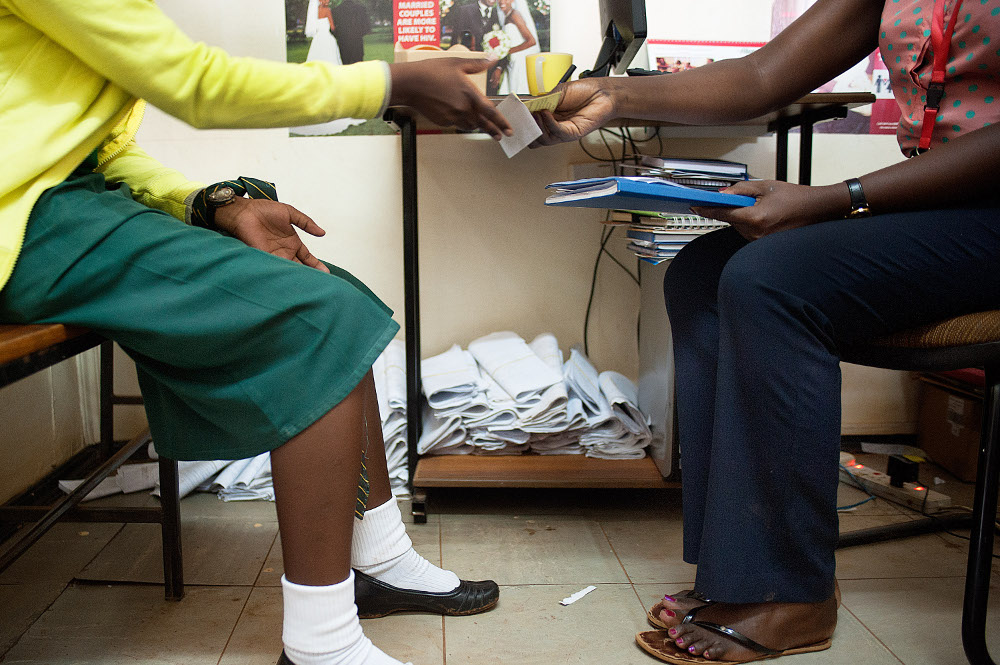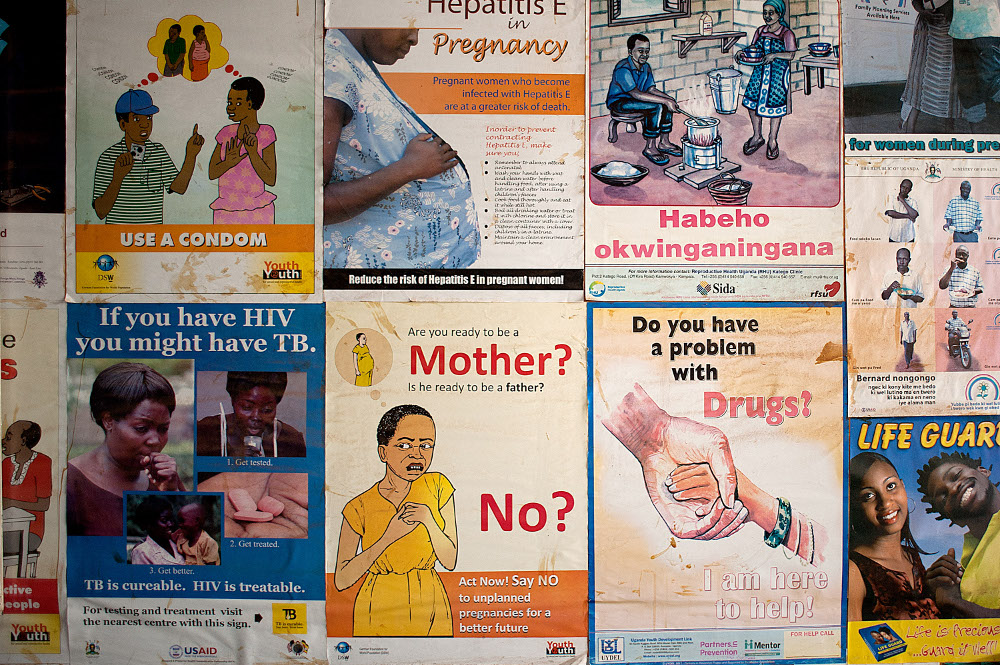Young people in Uganda can go to youth-friendly clinics for sexual health problems.
Asia Babirye, 20, looks around nervously. She can’t believe what she’s seeing. A soap-like drama about sexual issues is unfolding on a huge TV screen. Young men and women are sitting on chairs, waiting, eyes glued to the screen.
“It doesn’t look like a clinic,” Babirye thinks to herself.
A nurse at the reception greets her.
The room’s walls are covered with posters of young people who discuss sex in a way young people such as Babirye can relate to. There are also leaflets, condoms and a suggestion box.
Babirye is from Luzira, a suburb near Uganda’s capital, Kampala. It takes her about 30 minutes to get to the Naguru Teenage Information and Health Centre in Kampala with public transport.
She picks up one of the flyers. It tells her more about teenage pregnancy. According to Uganda’s health ministry, the pamphlet says, one out of four Ugandan teenage girls falls pregnant by their 19th birthday and 49% get married before they turn 18.
“I didn’t know that,” Babirye whispers to herself. “I thought the figure was far lower.”
She takes a seat and starts to watch the television drama.
Health challenges the world over
“Adolescents constitute the highest demographic segment in Uganda, yet sexual and reproductive information and health services to meet their needs are still limited,” says the director general of health services in the health ministry, Ruth Aceng.
She says young people in Uganda face health challenges similar to those faced by young people in the rest of the world: early or unwanted pregnancies, unsafe abortions, sexually transmitted infections and sexual abuse.
The Naguru centre is run parallel to a health facility serving adults, the Kiswa health centre. Although the two facilities are in the same compound, they’re in separate buildings. The staff is assisted by young volunteers who are on vacation and waiting to start university.

Ugandan youth can go to Naguru clinic to consult with volunteers. (Will Boase)
The centre’s deputy director, Denis Lewis Bukenya, says young people need to be handled in a sensitive way, because they’re often uncomfortable with talking about reproductive health issues. “They come in and say they have a headache when in actual fact they have a sore penis,” he says.
Godfrey Walakira from the Ugandan youth organisation, the Straight Talk Foundation, agrees: “Young people want to be able to go and test for say, HIV, without the health worker going to tell their parents.”
Bukenya says all the centre’s staff members received special training in how to deal with adolescents.
Providing nonjudgmental care
Babirye is visiting the teenager information centre to see a doctor and to collect contraception.
“They are not rude and do not judge me,” she says. “I get what I want easily. Even the medication is for free.”
At facilities without specialised youth services, young Ugandans often feel judged by nurses and doctors, particularly if they visit the clinic to collect contraception or when they suffer from sexually transmitted infections, according to a 2007 study published in the Journal of Adolescent Medicine and Health. The study also found that a lack of privacy and confidentiality sometimes keep young people from visiting health facilities.
Uganda has two types of youth-friendly health facilities. The more expensive version is clinics like the Naguru centre, where young people can go to a separate building with dedicated staff. The more affordable option is “youth corners” in public hospitals where young people are served alongside adults, but in separate rooms or on specific days.
 Posters at the Naguru clinic in Uganda give advice to youth on sexual health concerns. (Will Boase)
Posters at the Naguru clinic in Uganda give advice to youth on sexual health concerns. (Will Boase)
Babirye prefers the teenage information centre to the youth corners, because she doesn’t run the risk of running into adults she knows. “I don’t have to be embarrassed if I came to collect contraception or to use other services relating to my sexual life,” she says.
Because the centre has dedicated staff, Babirye believes the likelihood of them sharing her medical information with other adult patients is lower. In youth corners, the same staff serve both young and older people.
Financial limitations on the state
But, according to Wilberforce Mugwanya, from the Ugandan health ministry’s reproductive health division, the Ugandan government cannot afford to create separate facilities such as the Naguru centre. Uganda’s per capita gross domestic product is only $714, according to the World Bank.
Mugwanya says the Naguru model requires a fully fledged health service unit, with “comprehensive structure, including buildings, equipment and staff, which implies doubling the cost of using a hospital or health centre. Most of these can only be supported by nongovernmental organisations and donor funding, which poses sustainability questions,” he says.
The Naguru centre is funded by the Swedish International Development Agency, which works closely with the Kampala city council authority and the Ugandan health ministry.
The centre served 28 746 clients in 2013, 32 196 in 2014 and 33 662 in 2015. According to Bukenya, the centre spends about $15 on each client, including on medicine, counselling and clinical services. It is open seven days a week. Many youth corner clinics are run only on one day a week.
Mugwanya argues that, although centres such as Naguru offer a much wider range of youth friendly services than the youth corners, and are also likely to have a bigger impact on adolescent health, the Ugandan government “has to work within the structures that we have”.
But Bukenya is not convinced that youth-friendly health services should be placed in the same building as general health services. “When these services are in a public hospital, the health workers get overwhelmed,” he says. “What the youth needs, is nonjudgmental health staff who have the time to serve them so that they can empower the youth with information and support which can save their lives.” – Additional reporting by Mia Malan
